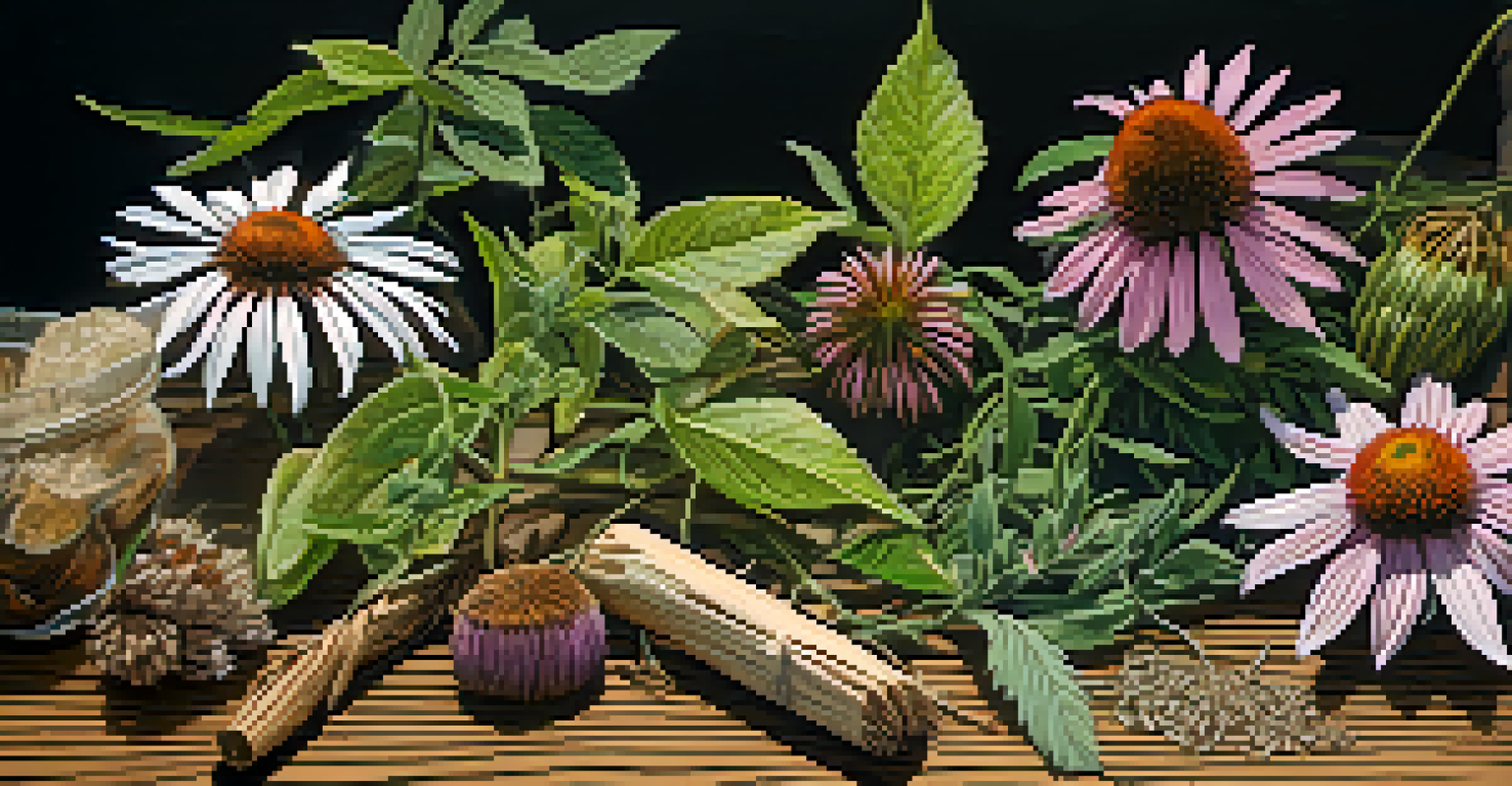Ethnobotany: The Study of Plants in Traditional Medicine

What is Ethnobotany and Why It Matters
Ethnobotany is the study of how different cultures use plants, particularly in medicinal contexts. It combines botany with cultural anthropology, exploring the relationship between humans and their natural environment. This field not only helps us understand traditional practices but also informs modern medicine by identifying potential new treatments.
The future of medicine will be about understanding the molecular and biochemical basis of traditional healing practices.
For instance, many pharmaceuticals are derived from plants used in traditional remedies. By studying ethnobotany, researchers can discover new compounds that may lead to effective treatments for various ailments. It's a fascinating intersection of science and culture that highlights the importance of preserving indigenous knowledge.
As we face global health challenges, the insights gained from ethnobotany are more valuable than ever. They remind us that nature holds secrets that can enhance our health and well-being, provided we approach it with respect and curiosity.
Cultural Significance of Plants in Healing Practices
Plants have held a crucial role in healing across cultures for centuries. From the herbal remedies of indigenous tribes to the acupuncture practices in traditional Chinese medicine, these methods showcase a deep understanding of plant properties. Each culture has its own unique approach, often intertwined with spiritual beliefs and rituals.

For example, Native American tribes use plants like echinacea and sage not just for their medicinal properties but also in spiritual ceremonies for healing. This connection between plant use and cultural identity highlights how integral these practices are to community health and cohesion. Ethnobotany seeks to document and preserve these invaluable traditions.
Ethnobotany Links Culture and Medicine
Ethnobotany combines cultural practices with plant-based medicine, revealing how traditional knowledge can inform modern healthcare.
Understanding the cultural significance of these plants allows us to appreciate not just their medicinal benefits but also their role in community identity. It raises awareness of the need to protect these traditions from the encroachment of modern industrial practices.
Notable Examples of Ethnobotanical Practices
One of the most prominent examples of ethnobotany in action can be found in the Amazon rainforest. Many indigenous tribes rely on the diverse flora for medicinal purposes, using plants like the ayahuasca vine for spiritual healing and psychological therapy. This practice has garnered international attention, leading to a growing interest in plant-based therapies.
Plants are our greatest allies in the quest for health and healing, and they hold the keys to our future.
Similarly, the use of willow bark by ancient civilizations for pain relief is a classic example. It contains salicylic acid, a precursor to modern aspirin, showcasing how traditional knowledge can benefit contemporary health practices. Such examples underscore the importance of studying these time-honored methods.
By examining these practices, researchers can identify plants that may hold the key to new medicines. These discoveries reinforce the idea that traditional practices are not merely relics of the past but vital sources of knowledge for future advancements in healthcare.
The Role of Biodiversity in Ethnobotanical Research
Biodiversity is essential in ethnobotanical research as it provides a vast array of plants that may possess medicinal properties. The greater the variety of plants, the higher the chances of discovering new treatments. This is particularly relevant in areas like rainforests, which harbor countless species yet to be studied.
However, biodiversity is under threat due to deforestation, climate change, and other human activities. The loss of these plant species not only diminishes our chances of finding new medicines but also threatens the cultural practices of communities that rely on them. Thus, preserving biodiversity is crucial for both ecological and medical reasons.
Biodiversity Is Key to Discoveries
The preservation of biodiversity is essential for discovering new medicinal plants and protecting the cultural practices of indigenous communities.
Organizations and researchers are increasingly advocating for the conservation of these ecosystems, recognizing their importance in sustaining traditional knowledge. By protecting biodiversity, we safeguard the future of both ethnobotanical practices and potential medical breakthroughs.
Challenges Facing Ethnobotanical Practices Today
Despite the wealth of knowledge in traditional medicine, ethnobotanical practices face significant challenges today. One major issue is the commercialization of traditional remedies, which can lead to the exploitation of indigenous knowledge without fair compensation. This raises ethical concerns about who truly benefits from these practices.
Moreover, globalization can dilute traditional practices as cultures merge and adapt to modern influences. Younger generations may turn away from their ancestral methods in favor of synthetic alternatives, risking the loss of valuable ethnobotanical knowledge. It’s a delicate balance between modernization and the preservation of cultural identity.
Efforts are being made to address these challenges through education and advocacy. By empowering indigenous communities and promoting awareness of the value of traditional medicine, we can help ensure that these practices are respected and preserved for future generations.
The Future of Ethnobotany in Medicine
The future of ethnobotany in medicine looks promising as more researchers recognize its potential. With the rise of holistic health approaches, there is a renewed interest in integrating traditional practices with modern medical science. This blending can lead to innovative treatments that consider not just physical ailments but also cultural perspectives on health.
For example, the use of medicinal plants in conjunction with pharmacology could enhance treatment protocols, offering a more comprehensive approach to patient care. Additionally, the growing popularity of herbal supplements and natural remedies among consumers highlights a shift towards valuing plant-based medicine.
Support for Traditional Practices Needed
Advocating for the rights of indigenous communities and promoting sustainable practices can help preserve ethnobotanical knowledge for future generations.
As we move forward, collaboration between ethnobotanists, healthcare professionals, and indigenous communities will be key. Together, they can unlock the full potential of traditional knowledge while ensuring that cultural practices are honored and preserved.
How You Can Support Ethnobotanical Knowledge
Supporting ethnobotanical knowledge begins with education and awareness. Learning about traditional practices and the plants used in different cultures can foster appreciation and respect for these invaluable resources. Consider attending workshops, reading literature, or even visiting botanical gardens that showcase ethnobotanical plants.
Another way to make a difference is to advocate for the protection of biodiversity and the rights of indigenous communities. By supporting organizations that promote sustainable practices and fair trade, you can help ensure that traditional knowledge is respected and preserved. Every small action counts in the fight against the commodification of traditional medicine.

Finally, consider incorporating more plant-based remedies into your lifestyle as a way to honor these traditions. Whether through herbal teas, essential oils, or other natural products, you can explore the benefits of ethnobotanical practices while supporting the ongoing study and appreciation of these rich cultural heritages.